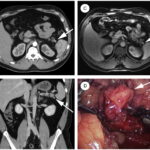Nephrotic syndrome is a clinical condition marked by heavy proteinuria (≥3.5 g/day), hypoalbuminemia, hyperlipidemia, and peripheral edema. It signifies a disturbance in the glomerular filtration barrier, primarily affecting the kidneys’ ability to retain proteins, particularly albumin. The syndrome is not a single disease but a manifestation of various underlying pathologies, both primary and secondary.

Pathophysiology of Nephrotic Syndrome
Nephrotic syndrome arises due to increased permeability of the glomerular basement membrane, allowing excessive loss of plasma proteins into the urine. This loss leads to decreased plasma oncotic pressure, triggering fluid retention, hypoalbuminemia, and activation of lipoprotein synthesis in the liver, resulting in hyperlipidemia.
Primary and Secondary Causes
Primary Glomerular Disorders
- Minimal Change Disease (MCD): Most common in children; responsive to corticosteroids.
- Focal Segmental Glomerulosclerosis (FSGS): Common in adults; may progress to renal failure.
- Membranous Nephropathy: Frequently affects adults; often idiopathic, but associated with malignancies and autoimmune diseases.
Secondary Causes
- Diabetic Nephropathy: Leading cause of nephrotic syndrome in adults globally.
- Systemic Lupus Erythematosus (SLE): Autoimmune etiology with immune complex deposition.
- Amyloidosis: Deposition of abnormal proteins within glomeruli.
- Infections: Hepatitis B, C, HIV, malaria.
- Drugs: NSAIDs, gold salts, penicillamine.
- Malignancies: Especially lymphomas and solid tumors.
Clinical Features of Nephrotic Syndrome
- Edema: Generalized and progressive, often starting in the periorbital region.
- Proteinuria: Massive urinary protein loss detectable on dipstick and 24-hour urine analysis.
- Hypoalbuminemia: Serum albumin typically <2.5 g/dL.
- Hyperlipidemia: Elevated LDL, VLDL, and triglycerides due to hepatic overproduction.
- Frothy Urine: Due to presence of protein.
- Fatigue and Weight Gain: Secondary to fluid accumulation.
Diagnostic Workup
Laboratory Investigations
- Urinalysis: Heavy proteinuria, lipiduria, oval fat bodies (Maltese cross appearance).
- Serum Tests: Low albumin, elevated cholesterol, normal to elevated creatinine.
- 24-hour Urinary Protein: Confirms nephrotic-range proteinuria (>3.5 g/day).
- Spot Urine Protein-to-Creatinine Ratio: Reliable alternative to 24-hour collection.
Serological Tests
- ANA, anti-dsDNA (SLE)
- HbA1c (diabetic nephropathy)
- Serum and urine electrophoresis (amyloidosis)
- Hepatitis B and C screening
- HIV test
Renal Biopsy
Essential for adults to identify underlying pathology unless contraindicated. In children with classic features, empirical treatment often precedes biopsy.
Complications of Nephrotic Syndrome
- Thromboembolism: Due to urinary loss of antithrombin III and increased platelet aggregation.
- Infections: Particularly with encapsulated organisms like Streptococcus pneumoniae.
- Acute Kidney Injury (AKI): Often from hypovolemia or interstitial nephritis.
- Hypocalcemia and Vitamin D Deficiency: Due to protein-bound vitamin D loss.
- Hypothyroidism: Secondary to urinary loss of thyroid-binding globulin.
Management Strategies
General Measures
- Dietary Modifications: Sodium restriction to manage edema; adequate protein intake to replace urinary losses.
- Fluid Management: Based on volume status; diuretics for significant fluid overload.
- Lipid-Lowering Agents: Statins for long-term cardiovascular risk reduction.
- Anticoagulation: In patients with high thrombotic risk or confirmed thrombus.
Pharmacologic Therapy
Corticosteroids
- First-line in minimal change disease and some cases of FSGS.
- Dosage: Prednisone 1–2 mg/kg/day in children or 1 mg/kg/day in adults.
- Duration: Typically 8–12 weeks with gradual tapering.
Immunosuppressive Agents
Used in steroid-resistant, dependent, or frequently relapsing cases:
- Cyclophosphamide
- Calcineurin Inhibitors (Cyclosporine, Tacrolimus)
- Mycophenolate Mofetil
- Rituximab (Anti-CD20): Especially in steroid-resistant or relapsing minimal change disease.
ACE Inhibitors / ARBs
- Reduce proteinuria by lowering intraglomerular pressure.
- Protect against long-term progression to chronic kidney disease.
Prognosis and Long-Term Outlook
Children
- Majority with minimal change disease achieve complete remission.
- Some may experience relapses or steroid dependency requiring immunomodulation.
Adults
- Prognosis depends on underlying histological subtype.
- FSGS and membranous nephropathy carry a higher risk of chronic kidney disease.
- Lifelong monitoring of renal function, proteinuria, and cardiovascular health is essential.
Preventive Strategies and Follow-up
- Vaccination: Pneumococcal, influenza, and hepatitis B vaccines are recommended.
- Regular Monitoring: Blood pressure, renal function, proteinuria, and serum albumin.
- Lifestyle Management: Weight control, smoking cessation, and physical activity.
Frequently Asked Questions:
What causes nephrotic syndrome?
Nephrotic syndrome is caused by primary glomerular diseases like minimal change disease, FSGS, and membranous nephropathy or by secondary conditions such as diabetes, lupus, or infections.
How is nephrotic syndrome diagnosed?
Diagnosis is based on proteinuria >3.5 g/day, hypoalbuminemia, edema, and supporting lab findings. A kidney biopsy may confirm the underlying cause.
Can nephrotic syndrome be cured?
Certain forms, especially in children, can enter remission. However, others require long-term management to prevent progression.
What foods should be avoided in nephrotic syndrome?
Limit sodium intake and saturated fats. High-protein diets are not generally recommended unless advised by a physician.
Is nephrotic syndrome life-threatening?
While not immediately life-threatening, it can lead to serious complications like kidney failure or blood clots if untreated.
Nephrotic syndrome represents a significant clinical condition that necessitates timely recognition and tailored therapy. A multidisciplinary approach focusing on precise diagnosis, prompt treatment, and long-term follow-up can drastically improve patient outcomes. With advances in immunotherapy and a growing understanding of the molecular basis of glomerular diseases, future management strategies promise to be more targeted and effective.

